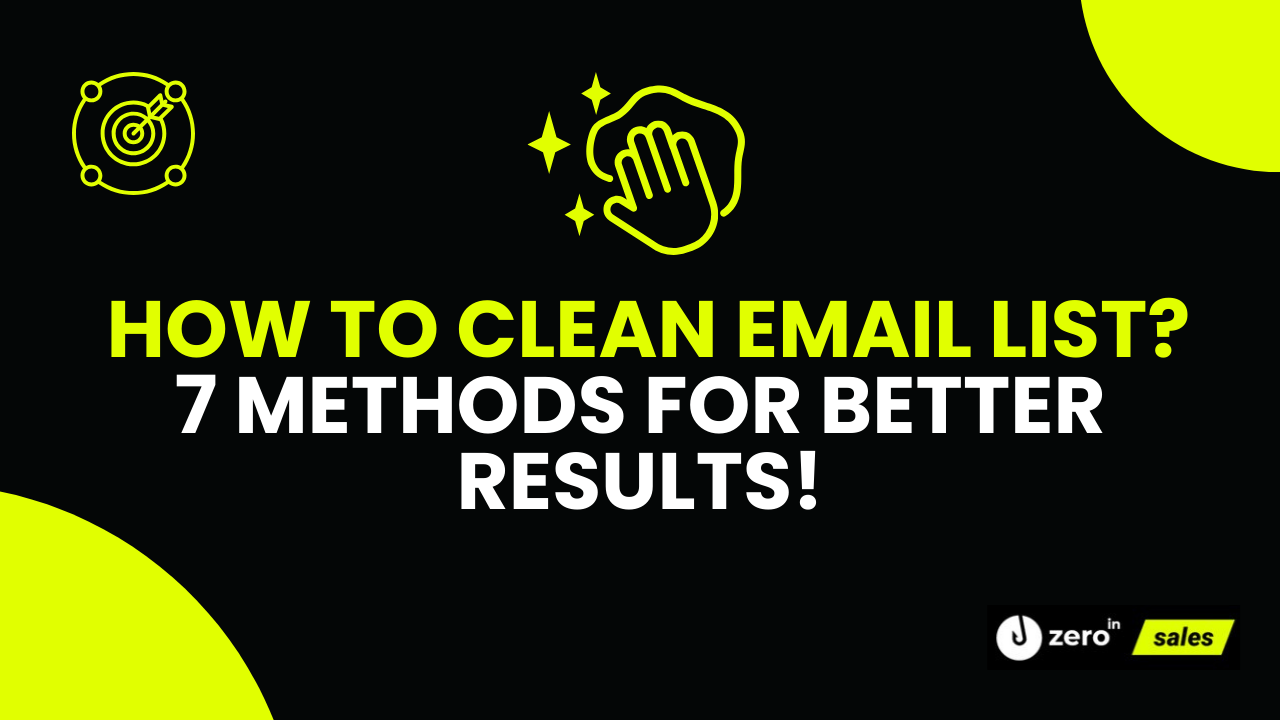Every unopened email is more than just a missed click.
It’s a missed connection, a missed conversation, a missed opportunity.
And every bounce-back?
That’s a direct hit to your credibility and your brand’s reputation.
It’s easy to get caught up in the thrill of crafting the perfect email, with its compelling subject line and engaging content.
But if those emails aren’t reaching the right inboxes, or worse, if they’re being flagged and tossed aside, all that effort is for naught.
The foundation of any successful email campaign isn’t just the content – it’s the quality and health of your email list.
If you’re serious about making an impact, about truly connecting with your audience and driving tangible results, then it’s time to give your email list the attention it deserves.
It’s time to clean, refine, and optimize.
Ready to dive deep and transform your email marketing game in 2023?
Let’s roll up our sleeves and get to work.
Summary
Maximize your email marketing by refining the very core: your email list.
Dive in to discover the importance, benefits, and best practices of list cleaning, and unlock the tools that’ll transform your campaigns.
From boosting deliverability to leveraging top-notch tools, here’s your roadmap to email list excellence!
What is Email List Cleaning?
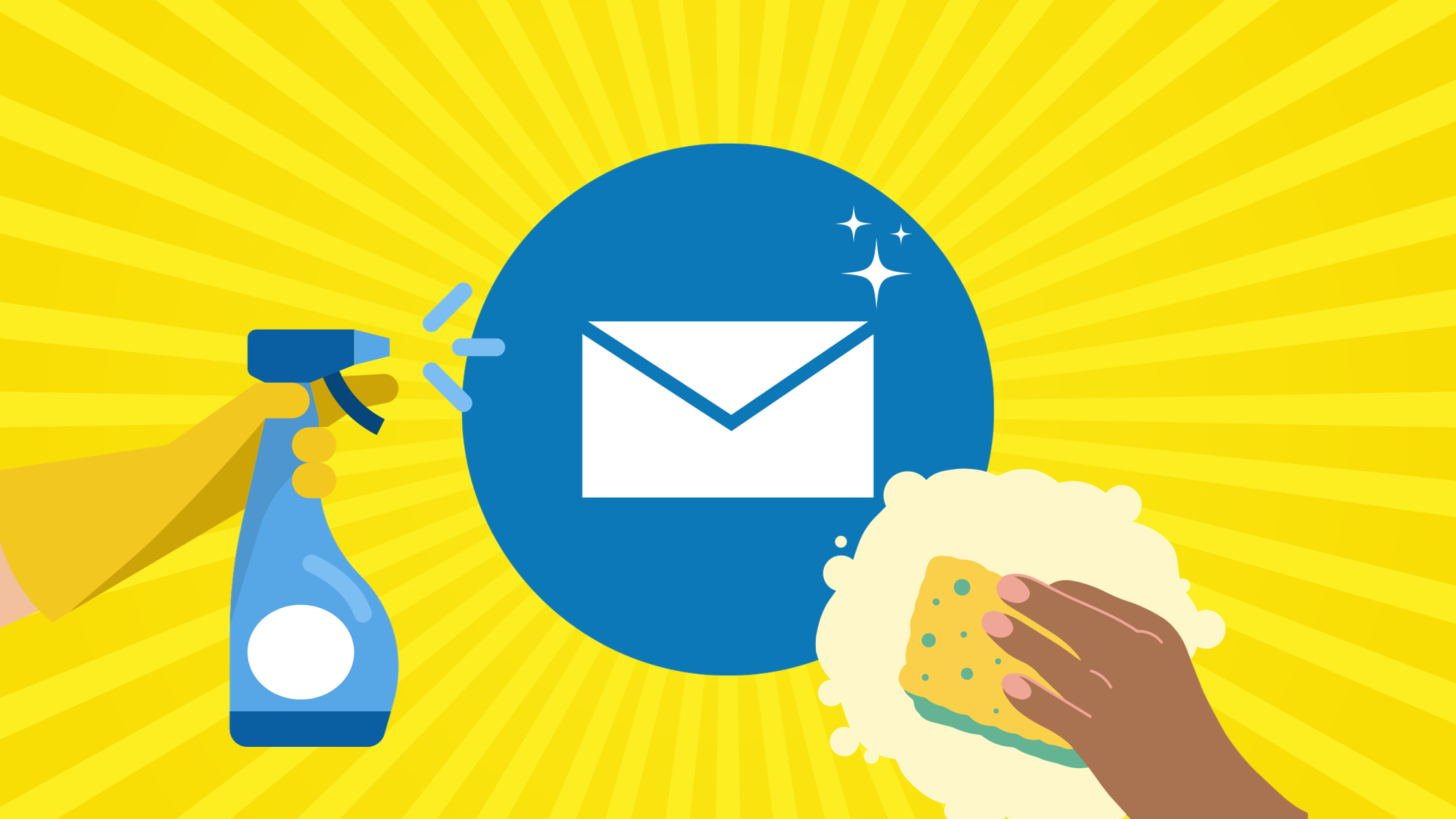
Email list cleaning is the process of sifting through your email database, weeding out inactive, invalid, or unengaged addresses.
It’s not just about trimming numbers – it’s about enhancing quality, ensuring your messages reach genuine, interested, and engaged recipients
By cleaning your list, you boost immediate metrics like open and click rates, while also ensuring long-term deliverability success.
Why is Cleaning your Email List Important?
Every marketer knows the power of a well-crafted email, but what’s often overlooked is the quality of the list it’s sent to.
Cleaning your email list isn’t just a task on a checklist – it’s a fundamental step in ensuring the success of your campaigns in 2023.
An uncleaned list is like a ticking time bomb, silently eroding your metrics, diminishing your sender reputation, and wasting your resources on dead-end addresses.
By cleaning your list, you’re not just removing inactive or invalid emails.
You’re refining your audience, ensuring that your messages are being sent to individuals who are genuinely interested, engaged, and more likely to convert.
This isn’t just about boosting immediate metrics like open and click rates.
It’s about the long game: ensuring consistent deliverability, building a strong sender reputation, and getting a true measure of your campaign’s impact.
In the vast and competitive landscape of email marketing, where every marketer is vying for attention, a clean email list gives you the edge.
It ensures that your efforts, time, and resources are directed towards genuine prospects, not lost in the void of inactive inboxes.
In the competitive world of digital marketing, a clean email list isn’t just an advantage, it’s a necessity.
What are Benefits of Clean Email List?
A clean email list is more than just a streamlined database – it’s the engine behind successful email marketing.
When you prioritize list hygiene, you’re not merely tidying up, you’re optimizing for peak performance. The benefits?
They’re tangible, impactful, and can significantly elevate your marketing game.
Let’s delve into the specifics of what a well-maintained email list can bring to the table.
Benefit #1 Improved Deliverability and Inbox Placement Rates
One of the most immediate and noticeable advantages of a clean email list is the boost in deliverability and inbox placement rates.
Think of it this way: every email that doesn’t bounce back or land in the spam folder is an email that has a chance to engage a potential customer.
By ensuring your list is free of invalid or unresponsive addresses, you’re effectively increasing the odds that your messages reach their intended destination: the main inbox.
This isn’t just about avoiding the dreaded spam folder – it’s about ensuring your content gets prime real estate in your recipient’s inbox, front and center, ready to make an impact.
Benefit #2 Higher Engagement and Conversion Rates
When your emails land in the right inboxes, the magic truly begins.
A clean email list means you’re reaching an audience that’s genuinely interested in what you have to say.
The result?
Higher open rates, more clicks, and increased engagement.
But it doesn’t stop there.
Engaged subscribers are more likely to take action, whether it’s making a purchase, signing up for a webinar, or simply sharing your content.
In essence, a refined list translates to a more engaged audience, and an engaged audience is a goldmine for conversions.
It’s a direct pathway to achieving the ROI every marketer dreams of.
Benefit #3 Accurate Metrics and Better Decision Making
But if your email list is cluttered with inactive or invalid addresses, or filled with spam, your metrics can be skewed, leading to misguided strategies.
With a clean email list, free from spam and invalid entries, you get a clearer picture of how your efforts are truly performing.
Open rates, click-through rates, and conversion metrics become more reliable. This accuracy is invaluable.
It allows for better A/B testing, more informed adjustments to your campaigns, and a clearer understanding of your audience’s preferences and behaviors.
Maintaining spam-free lists not only provides clarity but also ensures that your emails don’t end up as unwanted junk.
In short, a clean list provides the clarity needed to make smarter, data-driven decisions, ensuring your email marketing strategy is always on point and evolving in the right direction.
How Often Should you Clean your Email list?
The rhythm at which you clean your email list is as crucial as the act itself.
It’s akin to routine car maintenance; you wouldn’t wait for the engine to fail before getting an oil change.
Similarly, the frequency of your email list cleaning should be proactive, not reactive.
The ideal frequency, however, varies.
Factors like your industry, the rate of subscriber acquisition, and the nature of your initiatives play pivotal roles.
For instance, a dynamic e-commerce brand with daily sign-ups and high-volume initiatives might find monthly clean-ups beneficial.
In contrast, a specialized B2B tech firm, with a slower subscriber growth rate, might opt for bi-annual or even annual clean-ups.
Of course, there are more nuance to it.
Seasonal businesses, for example, might want to clean their lists post-holiday rush or after a major sale season. If you’re launching a new product or entering a new market segment, a clean list ensures your announcement reaches the most receptive ears.
But here’s the kicker: it’s not just about your industry or acquisition rate. It’s about the quality of subscribers you’re pulling in.
If you’re running aggressive campaigns with broad targeting, you might end up with a list that needs more frequent attention. Conversely, highly targeted campaigns might yield a cleaner list from the get-go.
The golden rule?
Keep an eagle eye on your metrics.
If you see a decline in open rates or a rise in bounce rates, take it as a nudge.
It’s your list telling you it’s time for a little TLC.
In essence, while a bi-annual review is a solid benchmark, it’s essential to tailor your cleaning frequency to your unique business rhythm.
It’s less about adhering to a strict timetable and more about ensuring your email list remains a robust, efficient tool in your marketing arsenal.
Regular, proactive maintenance not only prevents potential issues but also optimizes your list’s performance, ensuring you’re always communicating with an audience that’s tuned in.
By aligning your cleaning schedule with your business dynamics and industry trends, you ensure that your email efforts remain sharp, relevant, and effective.
What are the Risks of Unclean Email List?
An unclean email list isn’t just a minor oversight, it’s a potential pitfall with tangible consequences.
At the surface level, you might think it’s just a matter of sending emails that go unread, possibly being marked as spam.
But dig a little deeper, and the repercussions become clear.
First and foremost, there’s the risk to your sender reputation.
Email service providers (ESPs) keep a close watch on bounce rates.
High email bounce rates, resulting from invalid or non-existent email addresses, can flag your account.
This can lead to reduced deliverability or, in worst-case scenarios, getting blacklisted.
Once you’re on an ESP’s blacklist, even your valid emails might not see the light of day.
Then there’s the financial aspect.
Sending emails isn’t always free, especially when you’re dealing with large volumes.
Every email sent to an inactive or invalid address is money down the drain.
It’s like paying for a billboard that no one sees.
Over time, these costs add up, eating into your marketing budget without delivering any ROI.
Metrics, too, take a hit.
With a bloated list, your open, click-through, and conversion rates can be misleadingly low.
This skewed data can lead to misguided strategies, as you’re not getting a true reflection of your campaign’s effectiveness.
Lastly, there’s the missed opportunity.
Every email that doesn’t reach an engaged subscriber is a lost chance to connect, engage, and convert.
In the fast-paced world of digital marketing, you can’t afford to miss out on these opportunities.
Ultimately, an unclean email list is more than just an administrative hiccup.
It’s a risk to your reputation, your finances, and your overall marketing efficacy with lists that are not maintained properly.
The good news?
It’s a risk that’s entirely avoidable with regular list cleaning, ensuring your lists are free of spam traps and other threats.
How to Effectively Clean your Email List?
Cleaning your email list isn’t about haphazardly removing addresses left and right.
It’s a methodical process, requiring precision and a strategic approach.
Each step in the cleaning process targets specific issues, ensuring that by the end, you’re left with a list that’s not just smaller, but significantly more potent.
Whether you’re a seasoned marketer or just starting out, understanding the nuances of each cleaning method is crucial.
Let’s dive into the strategies that can transform your email list from a cluttered mess to a streamlined powerhouse.
Way #1 Remove Hard Bounces
Hard bounces are more than just minor inconveniences in the realm of email marketing; they’re glaring red flags.
When an email results in a hard bounce, it means it’s been sent to an address that’s either invalid or no longer exists.
This could be due to various reasons: the domain name might not exist, the recipient server might not be found, or the email address might be incorrect.
Every email that results in a hard bounce is essentially a wasted effort. It’s like sending a letter to a demolished building; it’s never going to be read.
But the implications go beyond just wasted resources.
Consistently high hard bounces can tarnish your sender reputation.
Email service providers (ESPs) monitor bounces closely, and if they notice a pattern of undeliverable emails from your end, they might flag or penalize your account.
This can lead to reduced deliverability in the future, meaning even your valid emails might struggle to reach inboxes.
To effectively manage and reduce email bounces rate, it’s essential to adopt a proactive approach:
Regular Monitoring: Keep a close eye on your email campaign reports. Most ESPs provide detailed analytics, highlighting which emails resulted in hard bounces.
Immediate Action: As soon as you identify an email address that has resulted in a hard bounce, remove it from your list. There’s no benefit in attempting to resend to these addresses.
Validation at Entry Point: Implement email validation tools or processes when people are signing up. This can catch many invalid addresses right at the entry point, preventing them from ever entering your list.
By rigorously managing hard bounces, you’re not only optimizing your current efforts but also ensuring the long-term health and efficacy of your email marketing endeavors.
Way #2 Address Soft Bounces
Soft bounces differ from hard ones in that they are typically temporary delivery failures.
They can be caused by a recipient’s mailbox being full, the email server being temporarily down, or the email message being too large.
While they might seem less severe than hard bounces, consistent soft bounces from a particular address can eventually be treated as hard ones by some ESPs.
Addressing soft bounces requires a more nuanced approach:
- Monitor Frequency
If an email address results in a soft bounce repeatedly over multiple campaigns, it might be indicative of a deeper issue.
Perhaps the recipient’s mailbox is perpetually full, or there are consistent server issues.
In such cases, it might be worth considering the removal of this address from your list.
- Adjust Email Size
If the soft bounce is due to your email’s size, consider compressing images or splitting your content over multiple emails. Emails that are quick to load have the added advantage of providing a better user experience. - Resend Strategically
For addresses that have soft bounced due to temporary server issues, consider resending your email at a later time. However, avoid bombarding the recipient with multiple attempts in quick succession. - Engage with Subscribers
If a particular subscriber’s emails are consistently soft bouncing due to a full mailbox, consider reaching out through alternative communication channels. They might not be aware of the issue and would appreciate the heads-up.
By addressing soft bounces proactively, you’re ensuring that temporary issues don’t evolve into permanent deliverability problems. It’s about maximizing the chances of your emails reaching their intended recipients every single time.
Way #3 Eliminate Duplicate Addresses
Duplicate addresses in your email list might seem harmless at first glance, but they can distort your metrics and lead to overexposure to certain subscribers.
Imagine someone receiving the same promotional email twice.
Not only does this waste your sends, but it can also annoy the recipient, leading to potential unsubscriptions or even being marked as spam.
Here’s how to effectively tackle duplicate addresses:
Regular Audits: Schedule periodic checks of your email list to identify and remove duplicate entries. Many email marketing platforms offer built-in tools to help you spot and eliminate these redundancies.
Optimize Signup Forms: Ensure that your email collection forms or platforms have mechanisms in place to prevent the same address from being entered multiple times. This can be particularly important if you’re running multiple sign-up initiatives simultaneously.
Segmentation: If you’re segmenting your email list for different campaigns, ensure that there’s no overlap that might result in a subscriber receiving the same email more than once.
Feedback Loop: Encourage subscribers to report if they receive duplicate emails. This not only helps you rectify the issue but also demonstrates to your subscribers that you value their experience.
By eliminating duplicate addresses, you’re ensuring a more streamlined and efficient email marketing process.
Way #4 Segment Inactive Subscribers
Subscriber engagement isn’t binary – it exists on a spectrum.
While it’s tempting to label subscribers as either ‘active’ or ‘inactive’, a more nuanced approach can yield better results.
By segmenting based on engagement levels, you can tailor your communication strategy to resonate more effectively with each group.
Here’s a refined approach to manage and segment subscribers:
Define Engagement Levels
Start by categorizing your subscribers into three main groups:
- Enthusiasts: These are your die-hard fans. They open and engage with your emails consistently.
- Occasional Readers: This group sporadically interacts with your content. They might open one email but ignore the next two.
- Dormant Subscribers: These subscribers rarely, if ever, engage with your emails.
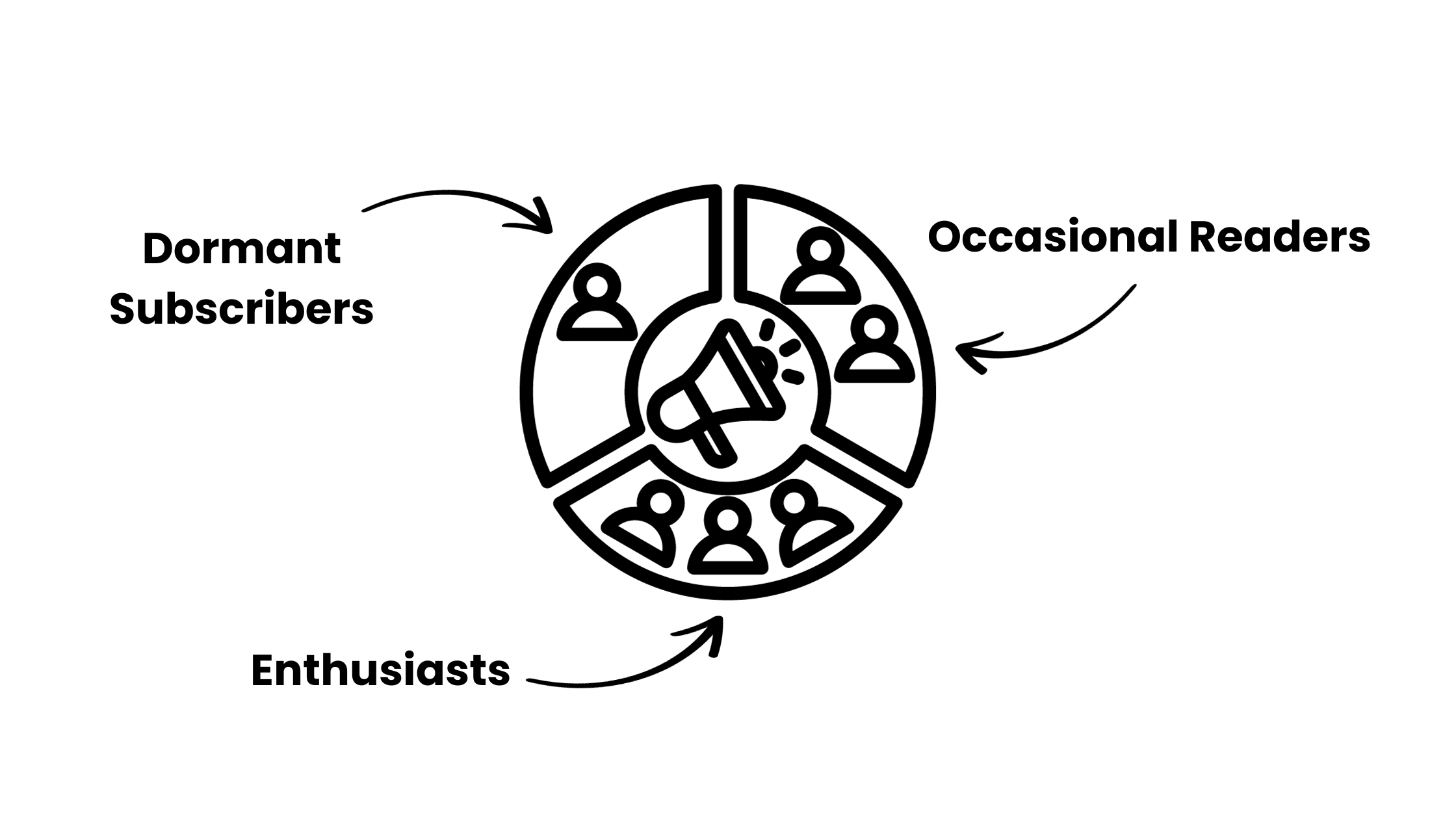
Tailored Communication: Each group requires a different communication strategy.
- Enthusiasts: Regular updates, exclusive offers, and perhaps even loyalty rewards to keep them engaged and appreciative.
- Occasional Readers: Re-engagement initiatives, surveys to understand their preferences, or spotlighting high-value content might pique their interest.
- Dormant Subscribers: A direct approach, like asking if they’re still interested in receiving your emails or offering a special incentive, can help reignite their interest.
Re-evaluate Periodically
Levels aren’t static.
An enthusiast today might become an occasional reader in a few months.
Regularly re-evaluate and re-segment your list to ensure your communication strategies remain effective.
Clean and Refresh
If, despite your tailored efforts, certain subscribers remain disengaged, consider removing them.
Remember, the goal is quality engagement, not just quantity.
By understanding the varying engagement levels within your subscriber base and tailoring your approach accordingly, you can foster better relationships, drive higher engagement, and ensure your email marketing remains effective and resonant.
Way #5 Remove Inactive Subscribers
While it’s essential to try and re-engage dormant subscribers, there comes a point when it’s more beneficial to part ways.
Continuously sending emails to those who show no interest can harm your sender reputation and skew your campaign metrics.
Moreover, it’s a waste of resources to target individuals who have clearly moved on.
Here’s a structured approach to dealing with inactive subscribers:
Last Chance: Before making the final decision to remove a subscriber, send them a ‘last chance’ email. This can be a heartfelt message asking if they’re still interested in staying connected or a special offer to reignite their interest.
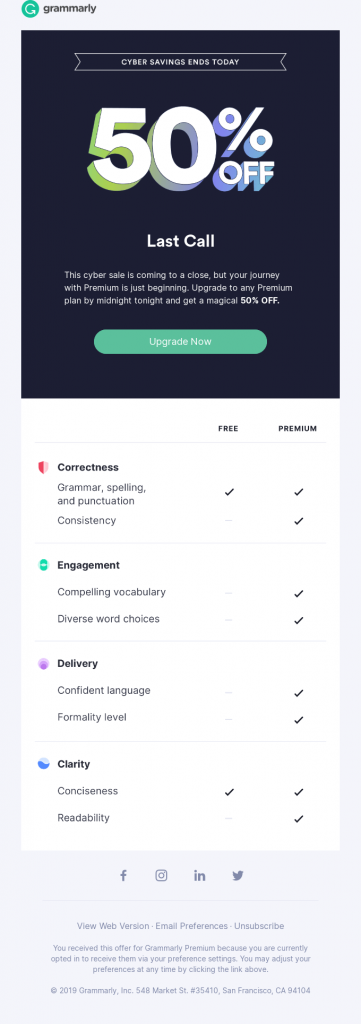
Feedback Loop: If they still don’t engage, consider sending a short feedback form. Understanding why they disengaged can offer insights to improve your future campaigns.
Respect Their Choice: If a subscriber chooses to opt-out or remains unresponsive, respect their decision. Remove them from your list. It’s essential to maintain a list of genuinely interested subscribers rather than chasing numbers.
Regular Audits: Make it a routine to periodically review your list for inactive subscribers. This ensures that your list remains fresh, engaged, and relevant.
By actively managing and, when necessary, removing inactive subscribers, you’re ensuring that your email initiatives are targeted, effective, and resonate with an audience that values your content.
Way #6 Understand Your Subscribers
To truly excel in email marketing, you need more than just a list of addresses; you need a profound understanding of the people behind those addresses.
By delving into the psyche, preferences, and behaviors of your subscribers, you can craft campaigns that resonate deeply and drive action.
Here’s how to cultivate a deeper understanding of your subscribers:
Know Your Ideal Customer Profile (ICP): Before you can understand your subscribers, you need to understand your ideal customer. What are their pain points? What drives them? What are their aspirations? By defining your ICP, you set a foundation upon which all your strategies can be built.
Surveys and Feedback: Engage directly with your subscribers. Periodically send out surveys or feedback forms, asking about their preferences, challenges, and what they’d like to see more of in your content.
Analyze Patterns: Delve into your analytics. Identify which emails garner the most attention, which topics strike a chord, and if there are specific times that yield peak engagement.
Personalization and Tailored Content: Beyond just using a subscriber’s name, personalization is about delivering content that aligns with their behaviors and preferences. This can be achieved by blending the insights from segmentation with tailored content delivery. If a segment of your audience shows a keen interest in a particular topic, ensure they receive content that caters to that interest.
Stay Adaptive: The digital landscape is ever-evolving, and so are your subscribers’ preferences. Continuously seek feedback, monitor trends, and be ready to pivot your strategies based on the evolving needs of your audience.
By taking the time to truly understand your subscribers, you elevate your email initiatives from mere communication to meaningful conversation. This deepened connection can lead to enhanced loyalty, heightened interest, and a significant uptick in conversions.
Way #7 Use an Email Verification Tool
In the vast ocean of email marketing, even a small leak can sink a ship. That leak? Invalid or incorrect email addresses. They can drastically affect your deliverability and tarnish your sender reputation. But here’s the silver lining: Email verification tools with advanced automation capabilities
Meet ZeroIn.
While primarily known as a stellar business email finder and data export tool for LinkedIn, ZeroIn doesn’t stop there. It boasts a robust email verification feature, ensuring that every address you gather is not just genuine but also active and relevant.
Why is this crucial?
Accuracy: With tools like ZeroIn, you’re not shooting in the dark. Every email on your list is verified through a precise automation process, ensuring that your efforts reach actual inboxes, not dead ends.
Resource Optimization: Every email sent costs money. By ensuring that every address is valid, you’re optimizing your resources, ensuring that every penny spent is towards genuine engagement.
Enhanced Deliverability: Email service providers love senders who have high deliverability rates. By using an email verification tool, you’re ensuring that your emails don’t just leave your outbox but also land in your subscriber’s inbox.
Reputation Management: Continuously sending emails to invalid addresses can flag you as a potential spammer. Verification tools with automation ensure that your reputation remains untarnished and your emails desired.
Incorporating an email verification tool, especially a top-tier one like ZeroIn, into your email marketing strategy is a game-changer. It’s about ensuring that every email you send is a step towards achieving your marketing goals.
What are Email List Cleaning Best Practices?
In the realm of email marketing, having a list is just the beginning.
The real magic lies in maintaining its health and vitality.
Just as a gardener prunes plants to encourage growth, marketers must adopt best practices to ensure their email lists flourish.
While we’ve touched upon the ‘how-tos’ of cleaning an email list, it’s equally vital to understand the overarching principles that guide these actions.
Let’s delve into the best practices that, when adopted, can transform your email list into a powerhouse of engagement and conversions.
Best Practice #1 Schedule Regular Cleanings
Imagine your email list as a high-performance sports car.
To keep it purring and responsive, you wouldn’t just fuel it up and drive endlessly.
You’d ensure regular maintenance checks, oil changes, and tire rotations.
Similarly, your email list demands consistent attention to keep it running at peak efficiency.
Setting a consistent cleaning schedule for your email list is akin to those regular car services.
Depending on the size of your list, the frequency, and the rate of subscriber acquisition, this could be a monthly, quarterly, or bi-annual ritual.
By routinely removing inactive or invalid addresses, you’re not just ensuring a smoother ride with optimized deliverability but also safeguarding the engine of your campaigns.
Moreover, every email dispatched consumes resources.
Think of it as the fuel for your car. Regular cleanings ensure that every drop of this fuel — every penny spent — propels you towards genuine, potential leads rather than getting wasted on dead-end streets.
And let’s not forget the reputation.
Just as a well-maintained car speaks volumes about its owner, a well-maintained email list boosts your standing with Internet Service Providers (ISPs).
They’re the traffic cops of the digital highway, and you certainly don’t want to be on their wrong side.
In the grand scheme of things, regular email list cleanings are about more than just maintenance.
They’re about ensuring the journey of your email marketing remains smooth, efficient, and impactful. It’s about reading the road ahead, preempting challenges, and steering your efforts toward success.
Best Practice #2 Use a Double Opt-In
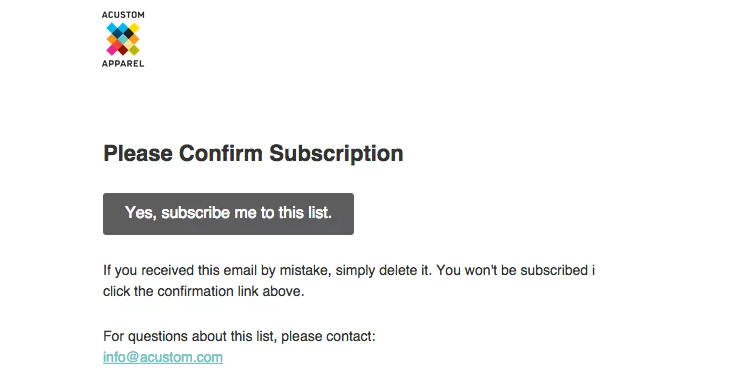
Navigating the bustling streets of email marketing requires precision.
Just as a GPS ensures you’re on the right path, a double opt-in ensures that the subscribers you’re adding genuinely want to be on your list.
It’s a two-step verification process: after a user subscribes, they receive a confirmation email to validate their intent.
This method might seem like an extra hoop, but its benefits are manifold.
Firstly, it filters out casual or accidental sign-ups, ensuring that your list is populated by genuinely interested parties. This not only boosts engagement but also reduces the chances of your emails being marked as spam.
Moreover, a double opt-in acts as a protective shield against bots or malicious sign-ups. In the age of cyber threats, this added layer of security ensures the integrity of your list.
In essence, while the allure of rapidly growing your email list is tempting, it’s the quality that truly counts. A double opt-in is that quality check, ensuring your email marketing vehicle is fueled by premium-grade subscribers.
Best Practice #3 Monitor Engagement
In the world of email marketing, engagement is the heartbeat. It’s the pulse that indicates the health of your campaigns.
Just as a car’s dashboard provides real-time data on speed, fuel, and engine health, monitoring engagement offers insights into how your emails are performing in the wild.
This isn’t just about open rates.
It encompasses a spectrum of interactions, from clicks to shares, and even the time spent reading your email.
These metrics offer a window into your subscribers’ minds, revealing what resonates and what falls flat.
By keeping a close eye on these metrics, you can fine-tune your efforts.
Notice a particular topic or format consistently getting high click-through rates?
That’s a sign to delve deeper into that area.
Conversely, if certain emails are consistently underperforming, it’s a cue to reevaluate and adjust.
Moreover, monitoring engagement can also hint at when it might be time for a list cleaning. A sudden drop, for instance, might indicate that a segment of your list has grown cold.
In the grand tapestry of email marketing, engagement is the thread that ties everything together.
It’s the real-time feedback mechanism, ensuring that your efforts remain agile, relevant, and impactful.
Always keep your finger on this pulse. It’s the compass that guides your email marketing journey, ensuring you’re always headed in the right direction.
Best Practice #4 Maintain a Sunset Policy
Every journey has its end, and in the realm of email marketing, this holds true for subscriber relationships as well.
A sunset policy is akin to the exit ramps on a highway, providing a structured way for subscribers to wind down their engagement, unsubscribe, or opt-out entirely.
Why is this necessary?
Because not everyone will be with you for the long haul. Interests change, needs evolve, and inboxes get cluttered. By having a clear sunset policy, you’re ensuring two things:
First, you’re respecting the subscriber’s choice.
If someone hasn’t engaged with your emails for a set period, the sunset policy can trigger a re-engagement campaign.
This could be a simple “We miss you” message or an offer designed to reignite interest.
If these efforts don’t bear fruit, the policy would then gracefully remove the subscriber from the list, ensuring they can easily unsubscribe.
Second, it’s about maintaining the health and efficiency of your lists.
Continually sending emails to unengaged subscribers not only skews your metrics but can also harm your sender reputation.
In essence, a sunset policy is about recognizing when it’s time to part ways. It’s a nod to the reality that while every subscriber is valuable, the ultimate goal is a list that’s engaged, responsive, and dynamic.
By letting go of the old, you make room for the new, ensuring your email marketing remains vibrant and effective.
Best Practice #5 Encourage Self-Cleaning
Empowerment is a potent tool.
In the context of email marketing, this means giving your subscribers the reins to manage their engagement with your lists.
Think of it as the adjustable settings in a car; some prefer a smoother ride, while others might opt for a sportier feel.
Similarly, subscribers have varied preferences on the frequency, type, and content of emails they wish to receive from your lists.
By providing options for subscribers to manage their preferences, you’re achieving a dual purpose.
Firstly, you’re enhancing their experience.
A subscriber who finds your weekly newsletters too frequent might prefer a monthly roundup.
By giving them this choice, you’re reducing the risk of them opting to unsubscribe entirely.
Secondly, this self-cleaning mechanism ensures that your lists remain optimized.
Subscribers who tailor their preferences are more likely to be engaged and responsive.
It’s a proactive way of ensuring that your emails align with their expectations, thus reducing the chances of them hitting the unsubscribe button.
Moreover, always ensure that the ‘unsubscribe’ option is clear and straightforward in your emails.
While it might seem counterintuitive, making it easy for subscribers to unsubscribe if they choose to is a sign of respect for their preferences and their time.
In the vast landscape of email marketing, it’s not just about the messages you send but also about how you allow subscribers to interact with them and manage their subscriptions on your lists. Encouraging self-cleaning is a nod to this two-way street, ensuring that your emails remain a welcome visitor in their inboxes.
Is there a tool for Cleaning your Email List?
Absolutely. Meet ZeroIn.
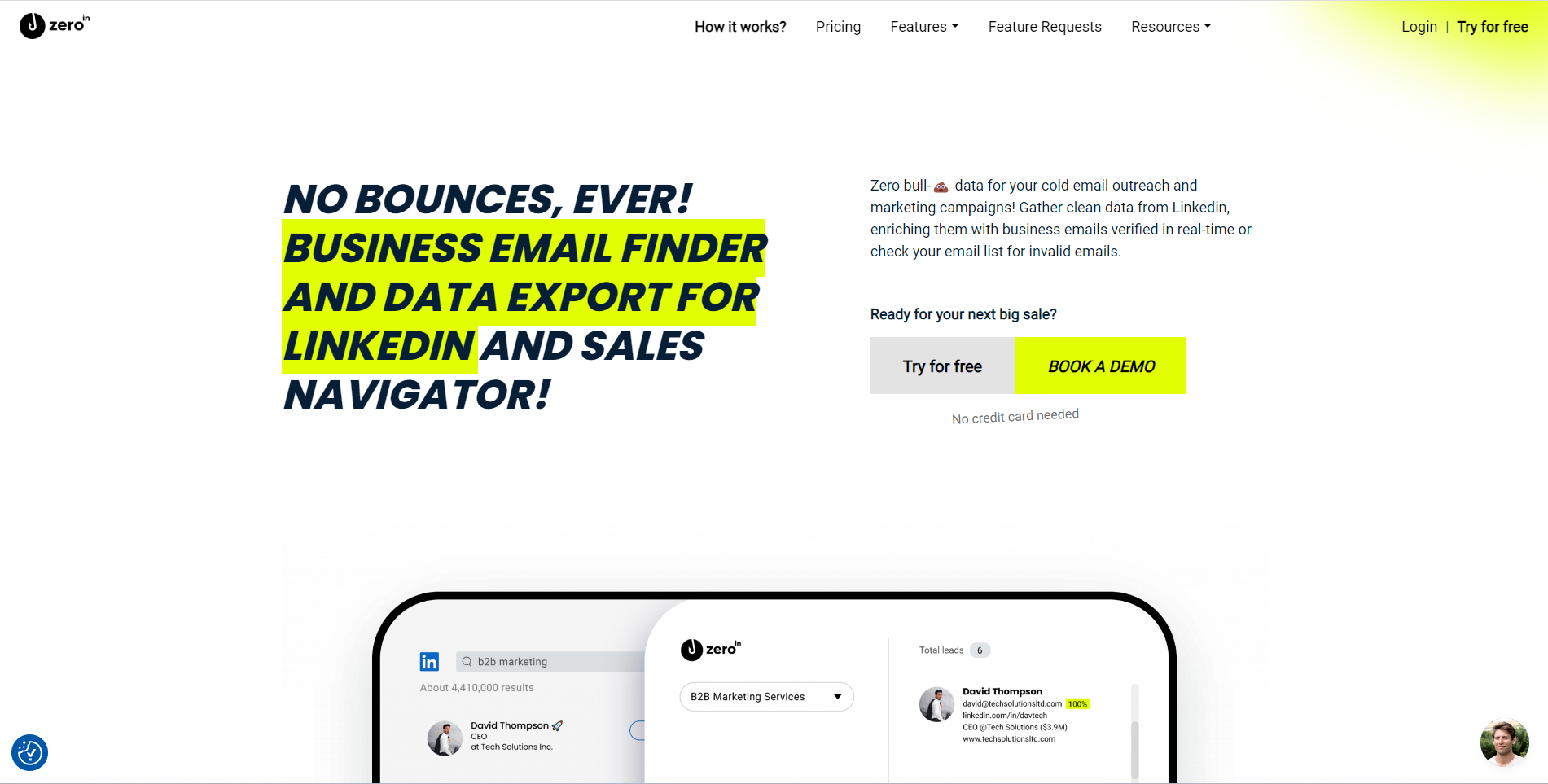
ZeroIn isn’t just another name in the crowded space of email finders. It’s a powerhouse, designed to be your go-to for business email discovery and data extraction from LinkedIn. But what makes it stand out?
Precision and Reliability
In a world where data drives decisions, ZeroIn ensures that the data you’re basing your decisions on is impeccable. With a staggering 98% accuracy rate, it’s not just about getting data; it’s about getting data you can trust.
Clean, Verified Data
ZeroIn isn’t in the business of offering stale or irrelevant information. Every piece of data is clean, verified, and ready for action. Whether it’s cold email outreach or intricate marketing campaigns, the data you get is primed for success.
Ethical Data Collection
In today’s digital age, data privacy isn’t just a buzzword; it’s a mandate. ZeroIn stands tall with its GDPR-aligned operations, ensuring that every piece of data is ethically sourced and compliant with global privacy standards.
Depth and Breadth
With ZeroIn, you’re not just skimming the surface. The tool provides a comprehensive 26 data points on leads and companies. This isn’t just data; it’s insight, allowing for a nuanced, personalized approach in your outreach.
Volume
Size does matter when it comes to databases. With access to over 200 million contacts, ZeroIn ensures that you’re never short of potential leads.
In the competitive arena of email marketing and lead generation, ZeroIn isn’t just a participant; it’s a frontrunner. It’s not merely a tool but a strategic partner, amplifying your LinkedIn Sales Navigator prospecting efforts. When you’re serious about scaling your outreach and achieving those ambitious sales targets, ZeroIn is the ally you want in your corner.
FAQs
What is Email List Cleaning
Email list cleaning is the process of sifting through your email database, weeding out inactive, invalid, or unengaged addresses.
Why is Cleaning your Email List Important?
Cleaning your email list is pivotal for the efficacy of your campaigns in 2023.
An unclean list erodes key metrics and tarnishes sender reputation.
By refining your list, you ensure emails reach genuinely interested recipients, enhancing deliverability and engagement.
In the competitive realm of email marketing, a pristine list directs resources effectively, ensuring messages aren’t lost in inactive inboxes.
What are Benefits of Clean Email List?
A pristine email list is the cornerstone of effective email marketing, acting as the catalyst for numerous advantages that can supercharge your initiatives.
Improved Deliverability and Inbox Placement Rates: A clean list ensures your emails find their rightful place in the main inbox, not lost in spam or bouncing back. This prime positioning amplifies visibility, setting the stage for impactful engagement.
Higher Engagement and Conversion Rates: With your emails reaching genuinely interested recipients, you witness a surge in open rates, clicks, and overall engagement. This heightened interaction paves the way for increased conversions, be it purchases, sign-ups, or content sharing.
Accurate Metrics and Better Decision Making: A refined list offers clarity. By eliminating inactive addresses, you gain a transparent view of your campaign’s performance. This clarity facilitates precise A/B testing, informed campaign adjustments, and a deeper understanding of audience preferences, ensuring your strategies are always data-driven and on target.
How often Should you Clean your Email list?
Maintaining your email list’s hygiene is akin to regular health check-ups; the frequency depends on individual needs but shouldn’t be neglected.
Factors like industry type, subscriber acquisition rate, and campaign nature influence the cleaning schedule.
However, always keep an eye on metrics.
A dip in open rates or a spike in bounces might signal it’s time for a clean-up.
In essence, while bi-annual checks are a good starting point, align your cleaning frequency with your business’s unique rhythm to ensure your email marketing remains effective and efficient.
What are the Risks of Unclean Email List?
An unclean email list poses multiple threats to your email marketing strategy, especially in 2023.
High bounces from invalid addresses can tarnish your sender reputation, potentially leading to blacklisting by Email Service Providers (ESPs).
This not only affects the likelihood of successful email delivery but also wastes financial resources, as sending emails to inactive addresses incurs costs without any return.
Moreover, with a cluttered list, your engagement metrics become unreliable, making it challenging to gauge campaign success accurately.
In essence, an unclean list jeopardizes your reputation, budget, and the effectiveness of your campaigns, underscoring the importance of regular list maintenance.
How to Effectively Clean your Email List?
Effectively cleaning your email list is a systematic process that involves several essential steps.
By following these methods, you ensure that your list remains optimized for maximum engagement and deliverability:
1. Remove Hard Bounces – Eliminate addresses that consistently return undelivered emails, as they’re either invalid or non-existent.
2. Address Soft Bounces – Monitor temporary delivery issues, such as a full inbox, and decide on a threshold for removal.
3. Eliminate Duplicate Addresses – Ensure each email address is represented only once to avoid redundancy and potential spam flags.
4. Segment Inactive Subscribers – Identify subscribers who haven’t engaged in a while and craft targeted re-engagement campaigns.
5. Remove Inactive Subscribers – After attempting re-engagement, it’s wise to remove subscribers who remain unresponsive.
6. Understand Your Subscribers – Dive deep into analytics to understand subscriber behavior, preferences, and tailor your content accordingly.
7. Use an Email Verification Tool – Tools like ZeroIn can verify the authenticity and activity of email addresses, ensuring your list remains clean and efficient.
What are Email List Cleaning Best Practices?
Maintaining a clean email list isn’t just about periodic cleaning – it’s about adopting best practices that ensure your list remains optimized over time.
Here are some fundamental guidelines to keep your email list in top shape:
1. Schedule Regular Cleanings – Just like any routine maintenance, set a regular schedule, be it monthly, quarterly, or bi-annually, to review and clean your list.
2. Use a Double Opt-In – Ensure that subscribers genuinely want to receive your emails by asking them to confirm their subscription. This reduces the chance of invalid addresses.
3. Monitor Engagement – Keep an eye on metrics. A sudden drop might indicate it’s time for a list cleaning.
4. Maintain a Sunset Policy – Set a threshold for inactivity. If subscribers haven’t engaged within a set period, consider them for removal or re-engagement campaigns.
5. Encourage Self-Cleaning – Occasionally prompt subscribers to update their preferences or unsubscribe if they feel the content is no longer relevant. This ensures your list remains engaged and interested.
Is there a tool for Cleaning your Email List?
Certainly!
While there are numerous tools available for email list cleaning, one stands out for its comprehensive features and reliability: ZeroIn.
Not only is it a formidable business email finder and data export tool for LinkedIn, but it also excels in verifying emails in real-time.
With ZeroIn, you’re not just getting a tool – you’re securing an ally for your email marketing endeavors.
Its high accuracy rate, GDPR alignment, and vast database make it an indispensable asset for any marketer aiming for precision and efficiency in their email marketing initiatives.
